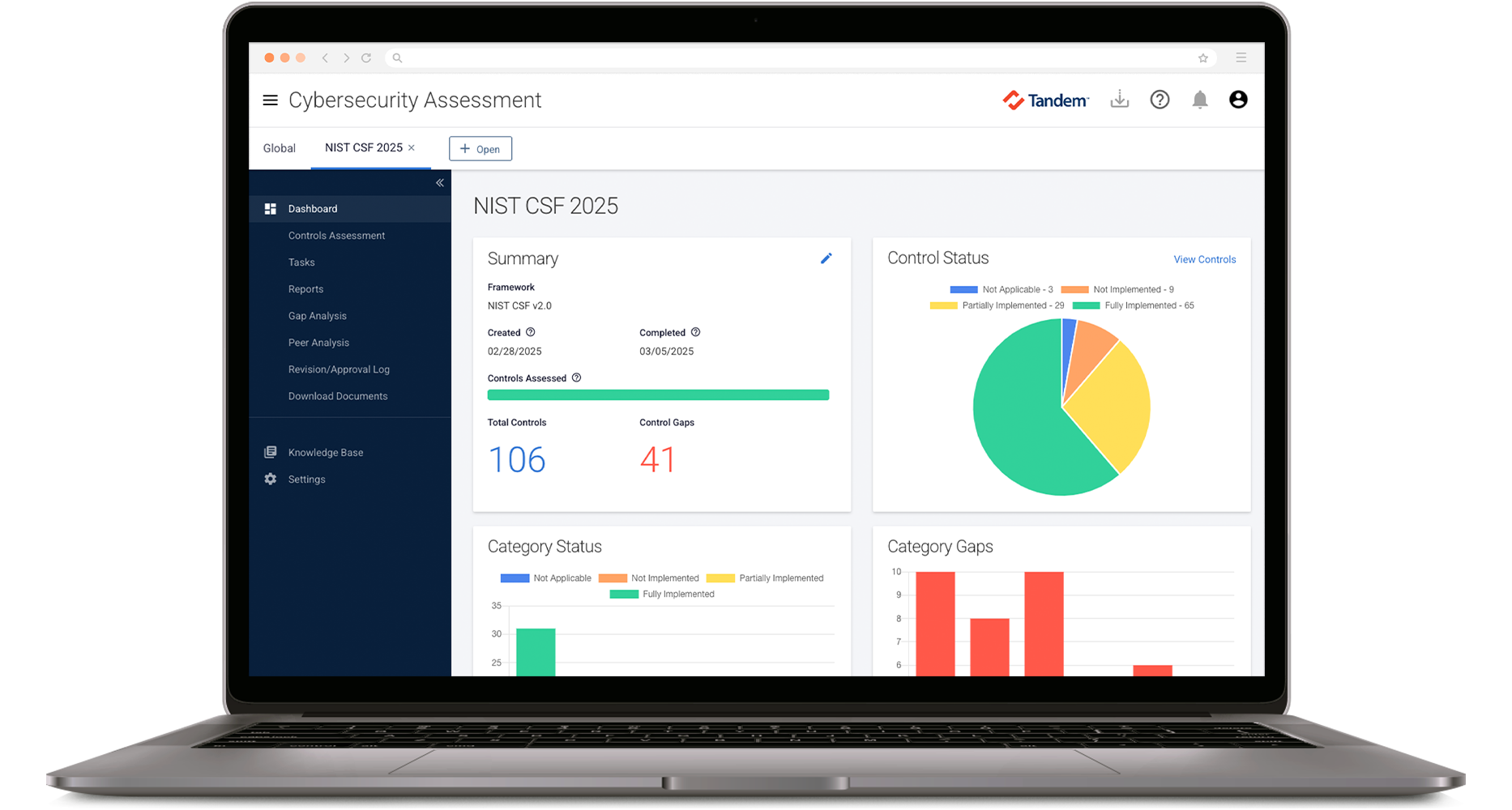The NIST Cybersecurity Framework (CSF) is a widely adopted, flexible framework that can help organizations of any size or complexity assess their cyber readiness. From large enterprises to small community banks, the NIST CSF's adaptable structure helps teams improve their cybersecurity posture without the pressure of rigid, one-size-fits-all standards.
However, when it comes time to complete an assessment based on the framework, you might find yourself asking questions like:
- Where do I start?
- Is the NIST CSF a reliable tool for reporting control maturity to leadership or regulators?
- What exactly are Tiers in the NIST CSF, and how should I be using them?
- Do I have to fully implement all of the outcomes?
- Do I need to apply all the implementation examples for each outcome?
- Do the FFIEC CAT statements connect to the NIST CSF in any way?
This blog is here to walk you through those common questions and offer practical tips to help you complete the NIST CSF in a way that actually works for you.
Frequently Asked Questions (FAQs)
Where do I start?
If you're wondering where to begin with the NIST CSF, you're not alone. It's one of the most common questions and fortunately, getting started doesn't have to be overwhelming.
If you are a bank or credit union, part of what makes the NIST CSF feel overwhelming at first is it presents a different experience from the FFIEC CAT. The FFIEC CAT answers tend to be very binary. Basically, your answers could be "Yes" or "No."
But the NIST CSF asks a different kind of question:
"How and to what extent have you achieved this outcome?"
That shift in mindset can feel uncomfortable, but it ultimately can be a good thing. Instead of checking a box, you're creating a more realistic view of your cybersecurity posture, which leads to stronger risk management.
So, before you even begin answering outcomes, consider Step 0: Adopt the mindset that the NIST CSF isn't a checklist. It's a tool for reflection, prioritization, and progress.
Now, onto the next steps.
Step 1: Get familiar with the framework.
NIST offers a helpful collection of Quick Start Guides designed to introduce the core concepts of the NIST CSF, including outcomes, implementation examples, mappings, and tiers. These resources are especially useful for smaller organizations or teams who are new to the NIST CSF.
Step 2: Choose how you'll manage the assessment.
Some organizations start by documenting their progress in spreadsheets or Word documents, and that can work. However, as your program grows, it may be helpful to use a dedicated software platform to streamline data entry, track progress over time, and generate professional reports. We'll talk more about that later in this blog.
Step 3: Establish your baseline.
Once you're ready to begin, start by setting your Current Profile. For each outcome in the framework, evaluate your current level of implementation (e.g., Fully Implemented, Partially Implemented, Not Implemented, etc.). This profile provides a clear starting point and helps identify areas for improvement as you build toward your cybersecurity goals.
Is the NIST CSF a reliable tool for reporting control maturity to leadership or regulators?
Yes. The NIST CSF was built specifically for the protection of critical infrastructure. This means it is a trusted and widely used framework across many industries, including the financial sector. One of the NIST CSF's greatest strengths is that it helps bridge communication gaps providing a clear structure that allows technical teams, leadership, and regulators to understand and discuss cybersecurity priorities in a consistent and meaningful way.
With the NIST CSF, you can clearly demonstrate:
- Where your organization stands today (Current Profile)
- Where you're headed (Target Profile)
- How you plan to get there (Gap Analysis and Action Plans)
When paired with tools that help you document and report your progress, it becomes an even more powerful way to communicate your efforts to both internal and external stakeholders.
What exactly are Tiers in the NIST CSF, and how should I be using them?
Tiers are used in the NIST CSF to describe how advanced and consistent an organization's cybersecurity risk governance and management practices are. There are four levels Partial (Tier 1) to Adaptive (Tier 4) which reflect how formal and proactive your organization is when it comes to handling cybersecurity risks.
That said, you don't need to put a lot of pressure on Tier selection. While Tiers can help you understand where your organization stands and where you'd like to improve, they're not the main focus of the framework.
According to NIST CSF 2.0: Using the NIST CSF Tiers Quick Start Guide:
"Tiers should be used to guide and inform an organization's cybersecurity risk governance and management methodologies rather than take their place."
You're not required to fit perfectly into one Tier or apply it to every piece of your program. In fact, NIST encourages organizations to customize the Tier descriptions, reuse the suggested ones, or use language that already fits your existing maturity model.
In other words? Don't overthink it. Use the Tiers to get a sense of where you are and where you'd like to go.
For example, consider the control PR.AA-01: Identities and credentials for authorized users, services, and hardware are managed by the organization.
- If you identify with Tier 1: Partial, then this control may have a status of "Fully Implemented" if you have a simple, manual tracking process for identities and credentials.
- If you identify with Tier 4: Adaptive, then this control may have a status of "Fully Implemented" if you have a robust, automated identity and credential management solution that is monitored in real-time.
Both are accurate assessments of the outcome's implementation based on the organization's security posture, while still leaving room to grow.
Do I have to fully implement all of the outcomes?
Not necessarily. The NIST CSF encourages organizations to review and address all outcomes, but it recognizes that full implementation may not always be feasible or necessary for every organization.
Your assessment approach should reflect your organization's size, complexity, risk, and needs.
For example, the GV.SC category in the NIST CSF focuses on Cybersecurity Supply Chain Risk Management (SCRM). As a smaller financial institution, you might not have a dedicated SCRM program. However, if supply chain risks are already being managed through your Information Security Program or Vendor Management Program, that can still satisfy the outcome.
What matters most is that the intent of the outcome is being met.
The key is to be intentional:
- If you're not fully implementing an outcome, document why, and
- Be clear about whether it's a gap to address later or simply not applicable due to your business model or risk profile.
The NIST CSF is flexible on purpose; it's designed to help you make informed decisions, not force a one-size-fits-all solution.
Do I need to apply all the implementation examples for each outcome?
The implementation examples are just that, examples. They're meant to offer ideas for how you could meet an outcome, but they're not requirements or a checklist you have to complete.
You might meet an outcome in a totally different way that fits better with your organization's size, resources, or structure, and that's perfectly fine. What matters is whether you're achieving the intent of the outcome, not whether you followed every example listed.
Especially if you're in a smaller organization, don't feel like you have to do it all. Use the examples as inspiration but do what makes sense for your environment and risk.
Do the FFIEC CAT statements connect to the NIST CSF in any way?
Yes, they do. The FFIEC CAT was developed using concepts from the NIST CSF, and many of its statements align closely with the outcomes. In fact, one of the original deliverables the FFIEC created was a mapping from the FFIEC CAT to the NIST CSF.
Because of this connection, if you've already completed an FFIEC CAT assessment, you'll likely see some familiar language and intent when working through the NIST CSF. Reviewing how your FFIEC CAT responses relate to the NIST CSF can help simplify the transition and cut down on duplicate work.
Using software tools can make this even easier. Platforms like Tandem include built-in mappings between the FFIEC CAT and the NIST CSF, along with import features that let you carry over applicable answers. This helps save time and keeps everything consistent.
Complete the NIST CSF with Software
If you're feeling more confident about tackling the NIST Cybersecurity Framework, great! That's the goal. At this point, we hope you've got a better understanding of what the NIST CSF is, how to approach common challenges, and how to shape it to fit your organization.
If you're looking for a tool to help you, the Tandem Cybersecurity Assessment product is built to support you. It gives you a structured way to complete the NIST CSF, track your progress, document your work, and generate reports that make sense to both technical teams and stakeholders.
If you're looking for a bit more support, check out our Tandem Partners. Our partners provide consulting services to help you build out and manage your security programs, including your cybersecurity assessments.
Ready to get started? Sign up and start your NIST CSF assessment for free at Tandem.App/Cybersecurity.



